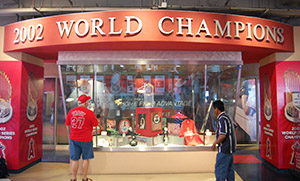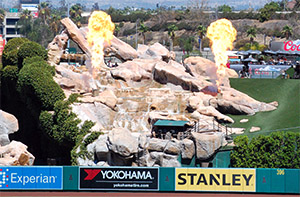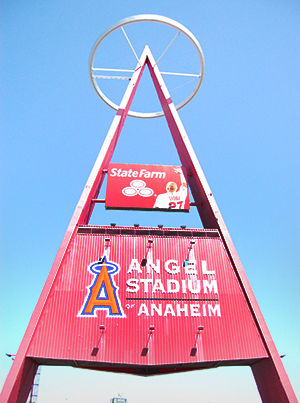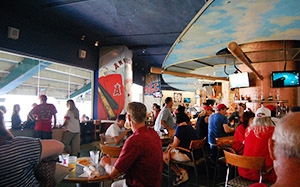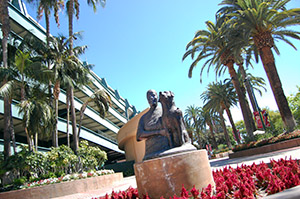THE BALLPARKS
Angel Stadium of Anaheim
Anaheim, California
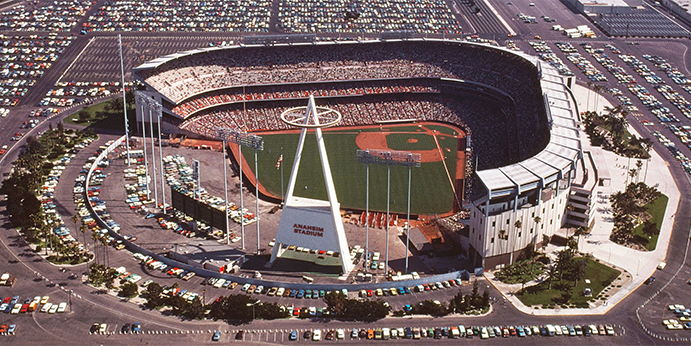
Courtesy of Angels Baseball
Forget Disneyland. For the Angels, the Happiest Place on Earth is the little slice of heaven they call the Big A, a plot of ex-farmland that once grew oranges and alfalfa but now spawns Salmon and Trout. And like your real housewives of the OC, the middle-age palace has undergone its share of makeovers—with the third time under the knife looking to be the sun-splashed charm.
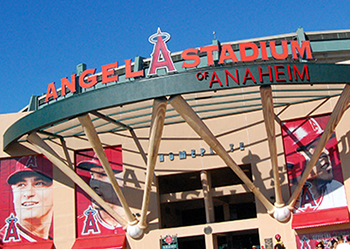 Amid the freeways, boulevards, dry riverbeds and laid-back office complexes, Angel Stadium of Anaheim offers up layers of the past. A row of trees splits Gene Autry Way as you enter the parking lot, evoking the long, orchard driveways bathed in cool shade that once drew you to the master’s house back in Orange County’s early agricultural days. At the south edge of the parking lot, the towering “Big A”—the ballpark’s distinctive feature that long ago served as the main scoreboard—now advertises coming events to passer-bys on the ten-lane Orange Freeway. And at the front of the main gate, an elated Mickey Mouse himself hangs out, heavily branded in devilish Angels Red and ready to pose with arriving fans who might remember a time when Disney briefly ruled over the franchise and restored the ballpark to its original, baseball-only purpose with a heavy coat of Magic Kingdom varnish splashed on.
Amid the freeways, boulevards, dry riverbeds and laid-back office complexes, Angel Stadium of Anaheim offers up layers of the past. A row of trees splits Gene Autry Way as you enter the parking lot, evoking the long, orchard driveways bathed in cool shade that once drew you to the master’s house back in Orange County’s early agricultural days. At the south edge of the parking lot, the towering “Big A”—the ballpark’s distinctive feature that long ago served as the main scoreboard—now advertises coming events to passer-bys on the ten-lane Orange Freeway. And at the front of the main gate, an elated Mickey Mouse himself hangs out, heavily branded in devilish Angels Red and ready to pose with arriving fans who might remember a time when Disney briefly ruled over the franchise and restored the ballpark to its original, baseball-only purpose with a heavy coat of Magic Kingdom varnish splashed on.
Inside Angel Stadium, more echoes of yesterdays stir. The right-field bleachers are all that remain of the ballpark’s expansion to a multi-purpose stadium back in 1980. For those sitting in the original three levels behind home plate and down the lines, the views looking out toward the San Gabriel Mountains are no longer blocked, even with minor, more recent foreground obstructions provided by the Honda Center (home to hockey’s Anaheim Ducks) and the 12-story Stadium Towers across the railroad from the parking lot.
The Disney touch is most noticeable behind left-center field with a giant faux rock pile lovingly referred to as the California Spectacular. Looking out of character for Orange County, the Spectacular seems more an ode to Utah—or to Frontierland, to the point that you expect the Big Thunder Mountain Railroad to come spinning through or one of those animatronic singing bears to pop up and start wailing away with a banjo. What the Spectacular does do is run recycled water down its petite rapids, shoot off water geysers and, whenever an Angels player goes deep, blast flames upward from two spouts, high enough that you might expect the alien head of the Great and Powerful Oz to angrily superimpose its way in between.
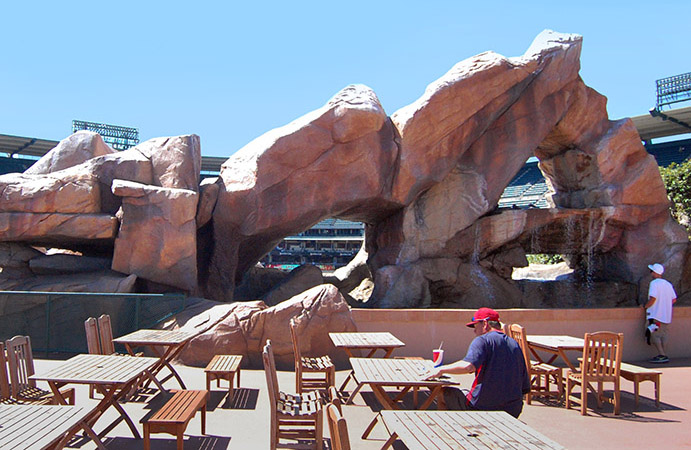
The backside of the California Spectacular, complete with rocky knotholes, waterfalls and a dining patio.
Angel Stadium looks quite sharp for its 50-plus years; walking around, it’s hard to believe that there’s only three active major league ballparks that are older. But that will happen when the building has been overhauled not once, but twice. When it opened in 1966, it carried the motto of “Convenience, Comfort and Courtesy,” and both host and guest continue to take that to heart. Angel Stadium may lack the intense vibe of a Fenway Park or Wrigley Field, but that’s okay. This is a suburban ballpark for suburban fans—and these days they show up in droves, knowing that a wonderful time will be had, win or lose. E-tickets and FastPasses need not apply.
From Ag to Riches.
One look at Angel Stadium and its present-day surroundings clearly show that Anaheim has come a long way from its rural roots. In the immediate years after World War II, most Americans knew only of Anaheim as one-third of a Jack Benny joke—you know, the one where the train is leaving on Track Five for Anaheim, Azusa and Rancho Cucamonga. Well before Walt Disney saw value beyond the ridicule and planted Disneyland among the agricultural fields, baseball found purpose in Anaheim as a springtime setting for numerous teams. The Philadelphia A’s and St. Louis Browns both briefly held spring training in Anaheim during the 1940s, and a decade later it was a hot preseason spot for many minor league squads, most notably the Hollywood Stars of the Pacific Coast League.
But Anaheim would become a potent nexus of two postwar booms: America’s Baby Boom in general, and the mass migration of Easterners to points west and California in particular. In 1950, Anaheim’s population was at 14,500; a decade later, it had mushroomed to over 100,000—and it was hardly going to stop there, with much farmland still to be bought, bulldozed and developed.
Enter Rex Coons. The mayor of Anaheim flew with a delegation of Orange County colleagues to Washington D.C. early in 1963 to help the region gain status as its own metropolitan statistical area, which would officially (to say nothing of symbolically) separate itself from Los Angeles. While awaiting word of the decision, Coons peered into the demographics of all other markets granted the designation and discovered that Orange County would be the only one without a major pro sports franchise. It suddenly hit him; Los Angeles had two baseball teams. One of them wasn’t happy.
The Los Angeles Angels, born in 1961, were in desperate need of a place of their own. They first played in aging, compact Wrigley Field (not to be confused with its better known Chicago namesake), then quickly fled to sparkling new Dodger Stadium, where they were forced to shell out exorbitant rental fees to the Dodgers in return for a very small piece of the revenue pie. Angels owner Gene Autry, the “Singing Cowboy” of radio, movies and television, looked to go elsewhere in town. Los Angeles politicians, paralyzed with fear over the rough experience of securing Chavez Ravine for the Dodgers, could only offer up potential ballpark sites at two abandoned reservoirs. Autry declined and looked southward—not to Anaheim, at first, but to Long Beach, which had better land to offer near El Dorado Regional Park. The Angels were on board until Long Beach officials made a fatalistic demand: Rename the team as the Long Beach Angels. For Autry, who insisted on either Los Angeles or California as his team’s geographical designation, this was a deal-breaker.
Autry next received a call from Rex Coons. Call yourselves whatever, the Anaheim mayor said, and we’ll take you in. Why not, Autry thought. After all, Orange County held unlimited promise. Residents there spent more of their income on leisure activities than those northward in Los Angeles; a ballpark could absorb some of the attention of tourists flocking to nearby Disneyland and Knott’s Berry Farm; and it could draw residual fans not only from Los Angeles but also from San Diego, whose suburbs were as close as 50 miles from Anaheim. Okay, fine, said Autry to Coons—just build us a ballpark by Opening Day 1966, and we’ll be there.
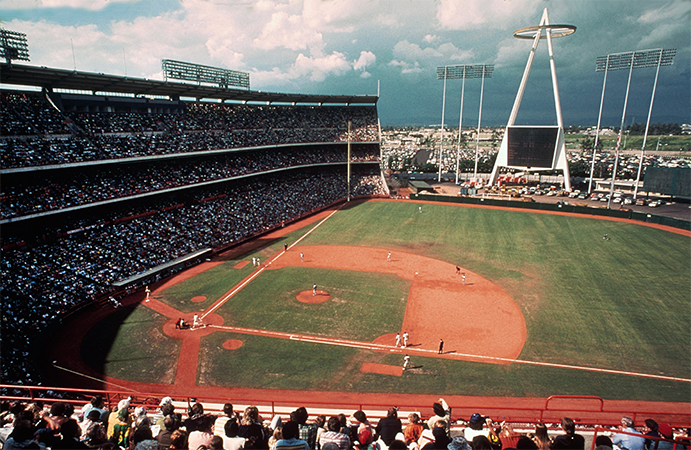
Angel Stadium as it originally looked in the 1960s, with the Big A scoreboard prominently featured behind left field. (Courtesy of Angels Baseball)
With less than two years to deliver on Autry’s deadline, Coons was already sweating, but then came this: Orange County pols, initially invested in the ballpark, backed out as some began to ponder whether private investment would better serve a new venue. This left the City of Anaheim all alone—and despite some squirming and citizen brushback, it forged ahead after receiving a commitment from contractor Del Webb—the same Del Webb who co-owned the New York Yankees—to build it on time. The second the deal was approved in August 1964, the shovels hit the ground to start construction.
A Big A for Effort.
Anaheim Stadium—as it would be called for its first 32 years—would be built on parts or whole of four different farms, growing produce ranging from alfalfa to oranges to corn. The payout to obtain the real estate was generous—a total of $4 million or, adjusted to the late 2010s, $30 million—so none of the landowners balked. There was lots of land for Anaheim to consider, but this plot represented the sweet spot for several reasons: It would sit near a confluence of three freeways—the Santa Ana (Interstate 5), the Orange (State Highway 57) and the Garden Grove (State Highway 22)—and it was right across the 5 from Disneyland, further encouraging tourists to jump on over to the ballpark after a day spent with Mickey, Goofy and Snow White.
The choice of Del Webb to build Anaheim Stadium was an interesting one. Born in Fresno and raised in the Southwest, Webb was certainly familiar to baseball through his ownership with the Yankees, but he had scant experience building ballparks, with only the upgrading of Kansas City’s Memorial Stadium in the mid-1950s to boast. But there was no mistaking the breadth and intrigue of Webb’s portfolio. In Arizona, he built everything from Japanese internment camps to the ambitious retirement community Sun City; in Las Vegas, he built casinos under the direction of mob kingpin Bugsy Siegel, who once eased Webb’s consciousness by telling him, “Don’t worry—we only kill each other.”
Webb visited and scrutinized many of the existing major league ballparks, telling reporters at the groundbreaking ceremony: “I’ve tried to observe the right and wrong of every stadium in the country. We want to get all the right things in this one and leave out all the wrong things.” Apparently one of the wrong things was bleacher seats; there initially would be none at Anaheim Stadium. What Webb did seek was to build three decks tightly around the playing field, from pole to pole and then some, reducing foul territory and bringing fans closer to the action.
Architecturally speaking, Anaheim Stadium was conservative, with few risks taken. “Convenience, Comfort and Courtesy” were prioritized above bold design statements. Protruding from the structure behind home plate would be a civic-looking façade that curved outward like a mirror reflection from the rest of the ballpark, and four pedestrian ramps fronted by a grassy garden speckled with palm trees, oases amid a larger concrete plaza spectators could walk straight onto from all points of the 12,000-car parking lot.
Beyond the appreciative yet mundane setting of the main structure, Anaheim Stadium’s primary conversation piece would stand tall and proud amid the vacant land and private parking spaces behind left field. The 230-foot-tall “Big A,” shaped as such with a scoreboard representing the typographical bar between two ascending, white steel pillars angled toward one another—and topped by a thin halo—stood taller than the Houston Astrodome’s apex and served as a heavenly beacon for Angels fans to congregate. Costing $1 million—a sum covered by Standard Oil, the ads and logo for which took up a portion of the open gap above the scoreboard—the Big A quickly became such a celebrated landmark, fans and reporters began nicknaming the whole ballpark after it.
Son of Dodger Stadium.
The Angels went to great pains in designing the symmetrical field dimensions to ensure that Anaheim Stadium would not become a pitcher’s paradise like Dodger Stadium, where hitters constantly grumbled about their failure to produce offense. But after exhaustive study of the wind patterns, the team set the distances almost on a par with the Dodgers’ home—and probably wished they had set them back even further when the ballpark’s first two games, exhibition contests against the San Francisco Giants, yielded 14 home runs. Once the games were played for real and the pitchers adjusted to the ballpark’s jet stream, however, it became quite clear that Anaheim Stadium would play as the Son of Dodger Stadium with its low scoring, feeble batting averages and deflation of home run power.
At first, 1-0 and 2-1 results didn’t matter to Orange County fans eager to finally see major league ball in their backyard. Season ticket sales nearly matched the Angels’ total attendance in their previous year at Dodger Stadium, and the inaugural 1966 Anaheim campaign drew 1.4 million fans to lead all ten American League teams. Pregame traffic jams were common before fans eventually figured out the best routes to Anaheim Stadium; sometimes the gridlock was so bad that it included many Disneyland tourists, convinced that’s where everyone else was headed.
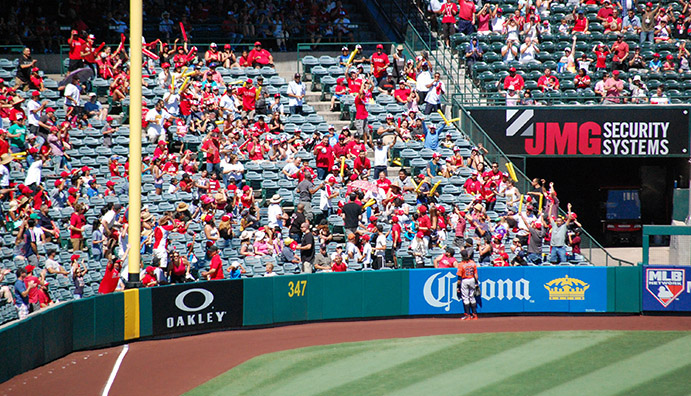
Angel Stadium mirrors northerly neighbor Dodger Stadium with its lower deck wrapping around the foul poles, and a short outfield wall that leaves the left fielder to occasionally compete with fans on a deep fly ball.
As the euphoria over the new ballpark thinned, so did attendance. Though the Angels occasionally topped a million fans through their first decade at Anaheim Stadium, it always seemed a challenge to do so. It didn’t help that the Angels couldn’t contend—or hit. They batted only .237 at home through 1976, bottoming out with a cringe-worthy .216 figure in 1968, the so-called “Year of the Pitcher.” Power-wise, things were worse—especially when the Angels ganged up to send a paltry 24 home runs over the Anaheim Stadium fence in 1976, making sarcastic headlines like the one Sport Magazine wrote up wondering if the team could collectively break Roger Maris’ season home run record. (With 63 in total, they barely did.)
Not surprisingly, the lone Angels superstar during this period did his work from the mound. His name was Nolan Ryan.
The Ryan Ultra-Express.
Angels fans not only saw Ryan at his best, but his über-best. Stolen along with three other players from the New York Mets in exchange for veteran third baseman Jim Fregosi (who immediately fizzled with the Mets), Ryan constantly dazzled and impressed with astonishing resilience—and he loved Anaheim Stadium from his first start on. Three times in his eight years with the Angels, he struck out 200-plus batters—just at home. In three different games at Anaheim, he struck out 19 opponents, twice in extra innings and the other a nine-inning affair that, at the time, set an AL record. He threw two no-hitters at Anaheim Stadium and six one-hitters—several of which could have ended up as no-no’s had it not been for slow infield grounders or well-placed pop-ups. In a time before intensive focus on pitch counts, Ryan sometimes threw as many as 200 in a game—and he always threw hard. At Anaheim on August 20, 1974 against Detroit, he darted one delivery at 100.9 MPH, the fastest ever thrown to date. “I don’t know if they picked up every pitch,” recalled Ryan in regard to the guys with the radar guns. “A lot of balls outside the strike zone have more velocity.”
Interestingly, attendance didn’t spike at Anaheim when Ryan took the mound, but the real diss took place after Ryan went 16-14 in 1979 as outspoken Angels GM Buzzie Bavasi didn’t want to bring him back because it would be cheaper to replace him with “two 8-7 pitchers.” Ryan would eventually make the Angels pay for those comments; when he returned to the AL a decade later at age 40-plus as a member of the Texas Rangers, he started five games at Anaheim Stadium against the Angels and completed four of them, throwing two shutouts, striking out 49 and surrendering just 20 hits and five walks over 41 innings. It seemed fitting that his 5,714th and last strikeout of his illustrious career came at Anaheim Stadium when he K’d Angels catcher Greg Myers on September 17, 1993.
Only Chuck Finley, who labored 14 years for the Angels, has won more games (89) at the Big A than Ryan. But of the 85 lifetime Anaheim victories accrued by the Ryan Express, 34 of them were shutouts—more than double the 16 produced by second-place Frank Tanana.
The Bigger A.
Sagging baseball attendance put constant financial stress on Anaheim’s public keepers of the ballpark; as the Angels continuously finished toward the back of the AL West, Anaheim Stadium continuously finished in the red with the bottom line. From the beginning, Anaheim had always sought a second tenant in the form of a pro football team; it came close to succeeding right off the bat when the San Diego Chargers, an original L.A. product tiring of playing at crumbling Balboa Stadium, appeared all but set to move into Anaheim Stadium in 1966. A move looked so certain that Chargers officials even went onsite to oversee construction of what would be their new team offices at Anaheim Stadium, but then San Diego voters gave the green light on a brand new multi-purpose stadium (Qualcomm nee Jack Murphy nee San Diego Stadium), keeping the Chargers put.
In the late 1970s, Anaheim Stadium tried to earn extra revenue any way it could. It staged more rock concerts, motocross events and brought in new (and briefly) successful tenants in soccer’s California Surf and the Southern California Sun of the short-lived World Football League. But just as they had wooed an unhappy Angels franchise out of Dodger Stadium 15 years earlier, local politicians were now sniffing out another disgruntled tenant in 1978 when they heard that the NFL’s Los Angeles Rams were looking to upgrade from their current situation at the ancient Los Angeles Memorial Coliseum. Anaheim and Orange County were hardly clandestine in their efforts to woo the Rams, even placing a full-page pitch to them in the Los Angeles Times. The ballpark would do more than just add 20,000 makeshift seats in right field, as had been planned for the Chargers back in 1966; this time the idea was to turn Anaheim Stadium into a fully enclosed, multi-purpose facility, tucking into the back of the second level 107 brand new luxury suites—all for the Rams to own and profit from. Like Gene Autry before him, Rams owner Carroll Rosenbloom was happily on board with the concept and told Anaheim he’d be theirs.
Autry and the Angels were fine with the ambitious $33 million project to enclose and expand Anaheim Stadium to 67,000 seats, even if it meant wrecking the baseball ambience. Just to be sure there was no ill will, the Rams played nice and offered to buy Angels season tickets for every row that butted up against the front of the new luxury boxes. But when Autry discovered that the expansion pact also called for a high-rise business complex to be built for the Rams on part of the existing parking lot, smiles became snarls. The Angels sued Anaheim, triggering a 12-year battle in which the Angels, the Rams and the City of Anaheim all took turns suing one another over control of the parking lot. Finally, in 1994, it was ruled that the lots belonged to the city but needed to be fully used by the Angels, negating any chance for development.
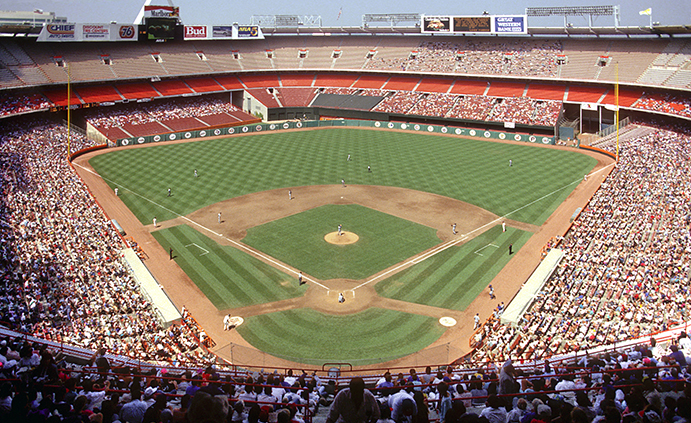
Anaheim Stadium after being enclosed to accommodate football. The field dimensions were kept symmetrical in front of a purely asymmetrical bleacher setup. (Jerry Reuss)
Overhauled, the Bigger A—as Anaheim Stadium was now humorously referred to—resembled San Francisco’s Candlestick Park (minus the arctic winds) with its enclosure forging a trapezoidal shape, gigantic football press box added into the third-base side of the upper deck and extra football seats folding out at an off-kilter angle, far from parallel with the sidelines. The remodel also avoided major embarrassment when someone noticed that the blueprints neglected to include bathrooms on the ground-level concourse.
Alas, expansion would lead to the demotion of the Big A scoreboard. It never had a chance to retain its existing spot with the three decks extending completely around the field, and moving it behind the enclosed structure would give it little purpose and pose a hazard should an earthquake topple it onto the stands. Enough sentimental value was placed upon the Big A to keep it from extinction; it was somehow placed on rollers and moved to the south end of the parking lot. In its place, a new scoreboard was perched above the top of the upper deck in left field with a petite version of the Big A frame atop it. All this, and Mother Nature’s shaking still made a dent; the 1994 Northridge earthquake caused the scoreboard, Little A and some surrounding ad boards to buckle 45 degrees toward the seats below.
While the relaxing views of the distant mountains were closed off with expansion, the action remained as close as ever for baseball fans using Anaheim Stadium’s original 43,000 seats. But the addition of the new seats forced the Angels to readjust the field dimensions. Had they simply moved the walls back to the front of the new, permanent bleacher seats, the Angels would have been looking at distances from 400 feet in left-center to 440 just to the left of straightaway center. In an effort to avoid a recreation of old Yankee Stadium’s “Death Valley”—and to retain symmetry—the Angels set up a fence in left-field to match the reframed distances in right, where new seating limited the power gap to a mere 370 feet. The smaller dimensions induced more home runs, and created space for a new bullpen behind the left-field wall in front of laid-back bleacher seats—the first 10 rows of which, for some reason, were never allowed to be occupied.
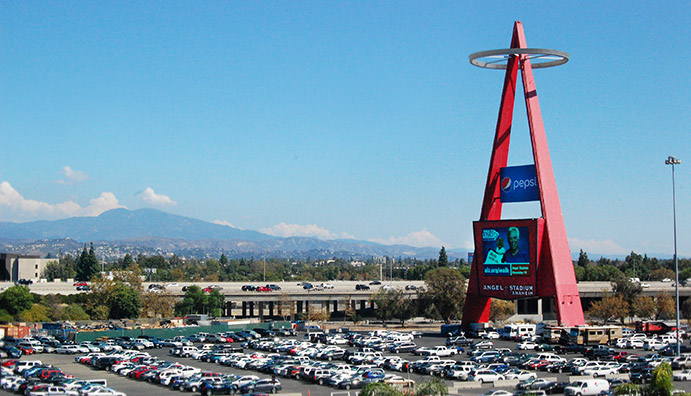
The Big A scoreboard was moved to the south end of the parking lot when Anaheim Stadium was enclosed in 1980; talk of bringing it back during the ballpark’s second makeover ended when it was determined it would be too costly to do so.
Bigger and Sometimes Better.
The reconstruction of Anaheim Stadium from tranquil ballpark to multi-purpose Frankenstein didn’t hurt the Angels. On the contrary, the franchise evolved into a borderline powerhouse as Autry became one of the more active players in the early years of modern free agency and transformed the team from a no-name, no-hit yawn into an All-Star unit headlined by the likes of Reggie Jackson, Rod Carew, Fred Lynn, Don Baylor and Bobby Grich. The Angels won their first three divisional titles during an eight-year stretch (1979-86) and ticket sales went through the roof, soaring past the two million mark in 1979 before bringing in a then-AL record 2.8 million in 1982. Anaheim Stadium’s enlarged capacity helped the Angels draw crowds in excess of 60,000 on occasion, but even when a sizeable turnout of 40,000 showed, team officials grumbled of how the joint looked half full.
Back to those three divisional titles. None of them translated into a pennant or world title, leading to bittersweet times for Angels fans. And it was never more bitter than in October 1986, when the Angels were a strike away from winning the American League Championship Series over the Boston Red Sox. But Dave Henderson’s two-run homer ruined the party, the Red Sox eventually won in extra innings—as well as the next two games back at Fenway Park—to take the series. Angels closer Donnie Moore, who served up Henderson’s home run, never physically or emotionally recovered from the moment, and killed himself three years later.
Long-time Angels fan Eric DeClue and his younger brother David, Boston-area natives raised as Red Sox fans before moving to Orange County in the late 1960s, witnessed the cruel irony of watching their former beloved stun their current beloved. The simple act of sulking back home wasn’t enough; they hopped into a car and drove through an open gate and into an empty Anaheim Stadium parking lot, camping out under the Big A message board and listening to the first game of the World Series between the Red Sox and New York Mets. The two simply kept reminding themselves that “the game should be here.” “We brought a case of beer and our anger over the events of the ninth inning,” recalled David, referring to the fateful Game Five. “We went over and over the sad facts while the game blasted out of the radio across the empty parking lot, drowned our sorrows and left a large pile of empty beer cans under the Big A.”
“The stadium stood silent as a tomb.”
Georgia Off My Mind.
The Rams’ tenure at Anaheim Stadium would be as brief and rocky as a ride at Frontierland. Owner Carroll Rosenbloom died shortly after the agreement to move the team to Anaheim, leaving the franchise in the hands of wife Georgia, who to some was little more than a gold digger soon to marry her sixth husband, Hollywood composer Dominic Frontiere. Georgia never liked the move to Orange County and made life difficult for Anaheim officials; she was temporarily appeased by being given an opulent, two-story luxury box that included a bedroom, sauna and Jacuzzi. But she sustained her antagonistic relationship with Anaheim and soon with Rams fans to boot as the team hit a long stretch of losing that brought average attendance at the Bigger A down to 43,000, a lousy figure by NFL standards. Georgia soon began courting with St. Louis on a possible new home for the Rams, and the new Mrs. Frontiere never hesitated. After 1994, the Rams were gone to Missouri, and the Angels regained sole possession of a stadium rebuilt for two.
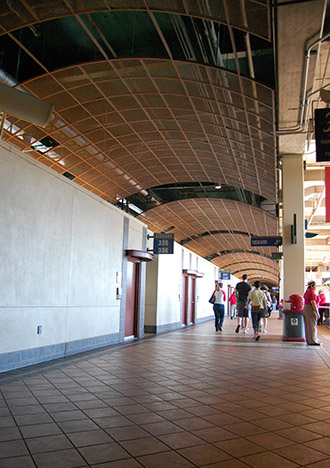 At the time, the Angels were in discussions with Anaheim on a brand new baseball-only park, but that all became moot when the Rams bolted. As Autry closed in on his 90th birthday, he ceded control of the team to Disney, which had been a stockholder going back to the franchise’s early days. In sync with its aggressive policy to continually enhance its assets—from theme parks to its numerous media holdings—Disney was in no mood to stick with the status quo at Anaheim Stadium, the enclosed behemoth looking passé amid the emerging retro ballpark trend. So it spared no expense in forging a team of renowned architects to consider a second makeover for the venue, returning it to its pre-multi-purpose glory—and then some.
At the time, the Angels were in discussions with Anaheim on a brand new baseball-only park, but that all became moot when the Rams bolted. As Autry closed in on his 90th birthday, he ceded control of the team to Disney, which had been a stockholder going back to the franchise’s early days. In sync with its aggressive policy to continually enhance its assets—from theme parks to its numerous media holdings—Disney was in no mood to stick with the status quo at Anaheim Stadium, the enclosed behemoth looking passé amid the emerging retro ballpark trend. So it spared no expense in forging a team of renowned architects to consider a second makeover for the venue, returning it to its pre-multi-purpose glory—and then some.
Partnering with Disney on the project would be, not surprisingly, HOK Sport, the Kansas City-based firm responsible for many of the recently built ballparks Disney sought to borrow ideas from; Robert A.M. Stern Architects, a New York shop Disney had previously hired to design Euro Disney; and some ‘in-house’ resources were utilized via Walt Disney Imagineering, which would ultimately be responsible for the California Spectacular rock pile and other unique gimmickry to be thrown into the revamped ballpark.
Asked to chip in on the $118 million renovation, the city of Anaheim nodded and ponied up $30 million on one condition: That the California Angels would from this point be referred to as the Anaheim Angels. Disney agreed, even as it passed up the opportunity to cross-promote the California moniker with California Adventure Park, the massive appendage to Disneyland in the process of being built.
Ballpark Redux.
The ballpark’s second major renovation would yield its current state. All traces of the 1980 expansion have been eliminated except for the right-field bleachers, a continuous section of seating that includes an extension of the second level from the right-field foul pole to center. A heightened (18 feet) fence with an out-of-town scoreboard stands at the bleachers’ base, while a monster of a main scoreboard, fronting a box-like lattice of naked steel, towers above them with a bank of lights serving as the cherry on top. Over in left, a smaller set of bleachers also soaks up afternoon sun, with both bullpens staggered upward and cutting into the first six rows. In between both sets of bleachers lie the California Spectacular, various shrubberies and an expansive area of fake grass sloping uphill behind the center-field wall as an extension of the batter’s eye. More seats were added behind home plate in the form of field-level dugout luxury boxes, one of which serves as the season ticket base for super-agent Scott Boras.
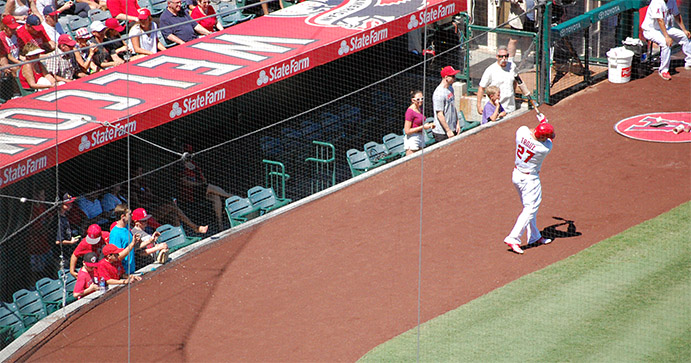
A group of excited kids get close to Angels superstar Mike Trout as he warms up to bat. As part of the renovation of Angel Stadium into its current state, the dugout boxes were added behind home plate.
Walking around the ballpark is more spacious than ever. The main concourse, one of two to serve the field level as most fans enter through the ground concourse below, has been widened to mimic the pleasing level of pedestrian comfort seen elsewhere at modern ballparks. Beyond the outfield, the concourse has spare room to walk even with the inclusion of a patio area near the California Spectacular, a second scoreboard behind left field (added in 2004) and, while he’s in an Angels uniform, a home run counter for slugger Albert Pujols—though why it’s placed far back behind the rock pile where almost no one can see it is mystifying.
The ballpark’s outer plaza has been expanded and rethought to be more utilized by fans before and during games. Fenced off from the parking lot by relatively elegant wrought iron, the plaza is home to leisurely spaced palm trees and other tropical species, food courts and the ballpark’s only two honorary statues: one of Gene Autry, the other of Rod Carew’s wife Michelle, who died of leukemia in 1996.
Overlooking the plaza from the second level between the patient pedestrian ramps are two semi-circular atriums with a round bar in the middle. One look at it and you’ll think you’ll have to empty out your wallet to buy an exotic drink, but keep in mind that Angel Stadium has, by the ounce, some of the most inexpensive alcohol in all of the majors.
The atriums’ presence is reflective of the extra breathing space fans now feel at Angel Stadium, even beyond the reintroduction of the mountain views beyond the outfield wall. It’s also a nicer looking building, with the dull “Battleship Gray” (as one Angels official put it) replaced by a combination of earthen sandstone beige and industrial green steel.
One last, very big piece of the puzzle was looked at, but Disney determined that the Big A wouldn’t be brought back from the parking lot to fit in its original spot behind left field. The reason: Too costly.
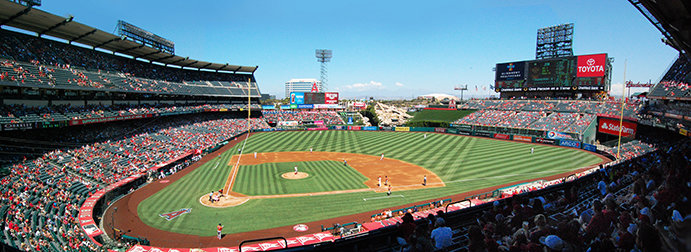
Angel Stadium was remodeled and returned to baseball-only status after the 1995 departure of football’s Rams.
Fair Game.
Field symmetry was also vanquished in favor of scoring symmetry. The result was a fair balance between pitcher and hitter, one that originally leaned toward the former and, after expansion, became a boon for the latter. Right field remains an easy poke with the power gap standing pat at 370 feet from home, but left-center has been given more room with the gaps reaching out as far as 396 feet.
The deep reach to left has not deterred some of the era’s greatest hitters. Alex Rodriguez remains, far and away, Angel Stadium’s home run leader among opponents, having clouted 38 in 102 games through 2015; he’s followed on the visitors’ list by Jose Canseco, Rafael Palmeiro and Juan Gonzalez. Among those never caught or accused of juicing, Reggie Jackson tops all with 18 when not dressed as an Angels (as he was from 1982-86). The cool bit about Jackson: He hit his first career home run on September 17, 1967 at Anaheim Stadium as a member of the Kansas City A’s; exactly 17 years later, he went deep at Anaheim for the 500th time while performing for the Angels; and exactly two years and 11 months after that, he belted his 563rd and final career shot at the ballpark, playing once more for the A’s.
The second renovation, started in October 1996, finished in time for the start of the 1998 season as the ballpark was renamed Edison International Field as naming rights were rewarded to the local utility. Attendance, which had dragged below the two million mark as fans began souring on the facility’s multi-purpose setup, began returning to the refreshed ballpark. The Angels also responded, as a group of talented homegrown players including Tim Salmon, Garret Anderson, Troy Glaus and Darin Erstad began lighting up the scoreboard and, as a result, the win column. The marketing department contributed, charging up the crowd with ear-splitting Thunderstix giveaways and the ultimate good luck charm in the Rally Monkey, a goofy capuchin that jumped up and down on the video board whenever the Angels needed a late-inning push. By 2002, it was all enough to finally send the Angels to their first World Series appearance—one which appeared doomed for defeat against the Giants in Game Six, with Anaheim nine outs from elimination and down five runs.
For Eric and Dave DeClue, it all seemed like 1986 all over again—minus the trauma of Dave Henderson’s enemy heroics. They stood along with everyone else for the seventh-inning stretch but noticed a good friend still sitting, lowering his head in anguish as Take Me Out to the Ballgame played. Cheer up, they said, put things in perspective—after all, things could be worse, as they were in 1986, Game Five, ninth inning. Then the Rally Monkey appeared, screeching and jumping; the fans became electric—and the Angels, on cue, scored three runs in the seventh, three in the eighth, closed out the Giants in the ninth and breezed the next night in Game Seven to give Orange County its first professional sports champion.
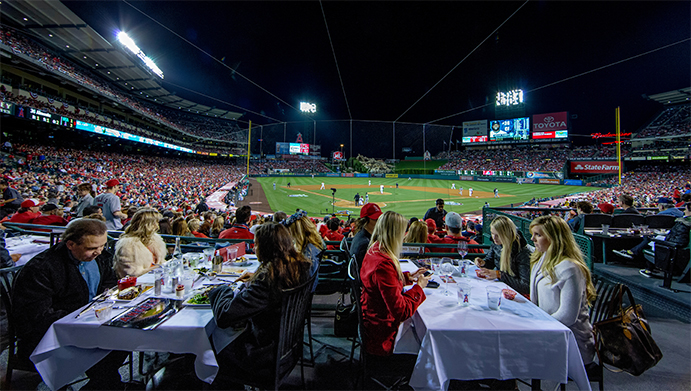
Only the most exclusive ticketholders are allowed in the Diamond Club Restaurant, where patrons can enjoy an upscale dining experience while hoping a foul ball doesn’t splash into a glass of Cabernet. (Courtesy of Angels Baseball)
How Much Longer?
Disney bowed out within a year, as did Edison International—exercising an option to take its name off the ballpark. New owner Arte Moreno proved popular with fans by reducing ticket prices, maintaining contender status and giving the ballpark a proud new name (Angel Stadium of Anaheim) without reaching into corporate billfolds; he became far less popular with Anaheim officials when he demoted the city through his bizarre retitling of the franchise as the Los Angeles Angels of Anaheim. The city sued, but the judge ruled that so long as Anaheim was part of the name as contracted years earlier, Moreno was legally in the clear.
Under Moreno’s reign, the Angels have enjoyed their greatest success at the gate to date—constantly bringing in over three million fans a year and, on occasion, even outdrawing the venerable Dodgers 40 miles up the freeway. But how long will the show continue to go in Anaheim? Moreno continually floated trial balloons that maybe a nearby town like Tustin could build him something new. Anaheim officials even tempted fate by allowing an opt-out for Moreno over 10 years before the Angels’ lease on the ballpark expired in 2029. The suspense was finally killed late in 2019 when the Angels agreed to buy the entire property—ballpark, lots and all—for $325 million. The deal forces the Angels to stick around the site through 2050, with options into 2065—the eve of the ballpark’s 100th anniversary. Of course, whether Angel Stadium will be once again remodeled or completely rebuilt by then will be up to Moreno; what is certain is that he plans to build around the ballpark, absorbing part of its voluminous sea of parking into mixed-use development that will encourage pre- and post-game activity outside of the yard and bring in added revenue to the Angels.
For now, the fans only care of baseball, the Angels and their ballpark, still looking breathless well into its middle age. The kids—who arguably visit this place more than any other—love it. Arriving at the main entrance, the original edifice of which has remained and been embellished with Mickey Mouse, an extended façade and two gigantic Angel caps, the youngsters look at the graphic awning, the diagonal bat pattern and the ballpark structure behind—and the goose bump factor is bound to be on a par with the experience of walking through the gates of Disneyland. This is, in short, a thoroughly pleasant baseball experience they often won’t forget.
The Magic Kingdom may win the day with the tourists. But for the locals, Angel Stadium is where it’s at.
 The Ballparks: Dodger Stadium The City of Angels felt the need to give the Dodgers the best chunk of available real estate in the Southland, literally moving mountains to wedge a jewel of a ballpark into the sloping, sun-baked Earth amid palm trees and Pacific breezes. Within sight of downtown and the towering San Gabriel Mountains in the distance, it’s a ballpark you can only love but cannot label. It’s not retro. It’s not modern. It’s just…perfect. It’s time for Dodger Stadium.
The Ballparks: Dodger Stadium The City of Angels felt the need to give the Dodgers the best chunk of available real estate in the Southland, literally moving mountains to wedge a jewel of a ballpark into the sloping, sun-baked Earth amid palm trees and Pacific breezes. Within sight of downtown and the towering San Gabriel Mountains in the distance, it’s a ballpark you can only love but cannot label. It’s not retro. It’s not modern. It’s just…perfect. It’s time for Dodger Stadium.
Los Angeles Angels Team History A decade-by-decade history of the Angels, the ballparks they’ve played in, and the four people who are on the franchise’s Mount Rushmore.


